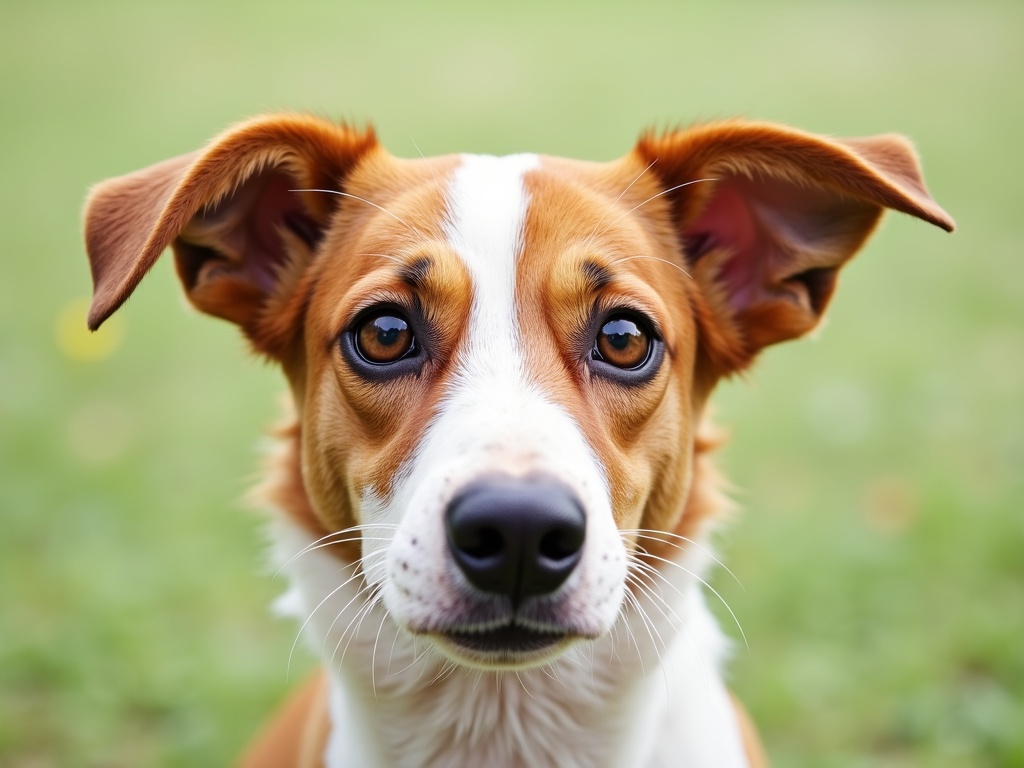What to Check For in a Dog's Ears and Eyes: A Comprehensive Guide
Imagine your furry friend, head cocked inquisitively, those big, soulful eyes gazing up at you. Are those eyes bright and clear, or a little cloudy? Are those ears perked and clean, or do they carry a telltale odor? Regular checks of your dog's ears and eyes are crucial for maintaining their health and happiness. Detecting potential problems early can save you both from unnecessary discomfort, vet bills, and even more serious health issues down the line. This guide will walk you through exactly what to look for, how to perform a basic examination, and when it's time to seek professional help.
Why Regular Ear and Eye Checks Are Essential
Dogs, with their inquisitive nature, are constantly exploring the world around them. This exploration, while enriching for them, also exposes them to potential hazards like allergens, bacteria, and foreign objects. Their ears and eyes, being particularly vulnerable, require vigilant monitoring.
**Early Detection:Regular checks allow you to spot subtle changes that could indicate an underlying problem.
**Prevention:Identifying issues early often allows for simpler and more effective treatment.
**Comfort:Addressing minor irritations promptly prevents them from escalating into painful infections or more serious conditions.
**Bonding:Performing these checks can be a positive bonding experience, strengthening the trust between you and your canine companion.
The Canine Ear: Anatomy and Potential Problems
A dog's ear canal is L-shaped, making it more prone to trapping dirt, debris, and moisture. This creates a perfect breeding ground for bacteria and yeast, leading to infections.
What to Look For in Healthy Ears:
**Cleanliness:The inner ear should be clean and free of excessive wax or discharge. A small amount of light brown wax is normal.
**Odor:A healthy ear should have little to no odor.
**Appearance:The skin inside the ear should be a healthy pink color, without redness, swelling, or irritation.
**Behavior:Your dog should not be scratching, rubbing, or shaking their head excessively.
Signs of Potential Ear Problems:
**Excessive Wax Buildup:More than a light coating of wax can indicate a problem.
**Unpleasant Odor:A foul or yeasty smell is a common sign of infection.
**Redness or Inflammation:Redness, swelling, or inflammation of the ear canal is a clear indicator of irritation or infection.
**Discharge:Any discharge, whether it's yellow, green, brown, or bloody, is a cause for concern.
**Head Shaking or Tilting:Persistent head shaking or tilting can indicate discomfort or pain in the ear.
**Scratching or Rubbing:Excessive scratching or rubbing of the ears, often against furniture or the ground, is a common sign of irritation.
**Pain or Sensitivity:If your dog shows signs of pain when you touch their ears, there's likely an issue.
**Aural Hematoma:A swelling on the ear flap filled with blood, usually caused by trauma such as excessive shaking.
Common Ear Issues in Dogs:
**Ear Infections:Bacterial and yeast infections are the most common ear problems in dogs.
**Ear Mites:Tiny parasites that live in the ear canal, causing intense itching and a dark, crumbly discharge.
**Allergies:Environmental or food allergies can often manifest as ear inflammation and infections.
**Foreign Objects:Grass seeds, dirt, and other debris can become lodged in the ear canal, causing irritation and infection.
**Aural Hematoma:As mentioned, this is a blood-filled swelling on the ear flap, commonly caused by trauma such as excessive shaking of the head.
The Canine Eye: A Window to Their World
A dog's eyes are not only expressive but also vital for their interaction with the world. Like ears, they're susceptible to various issues, some breed-specific.
What to Look For in Healthy Eyes:
**Clarity:The eyes should be bright and clear, with no cloudiness or discharge.
**Moisture:The eyes should be adequately moist, but not excessively watery.
**Symmetry:The pupils (the black centers of the eyes) should be equal in size.
**Color:The whites of the eyes (sclera) should be white, not yellow or red.
**Pupil Response:The pupils should constrict (get smaller) when exposed to bright light and dilate (get larger) in dim light.
**Blinking:Normal, regular blinking.
Signs of Potential Eye Problems:
**Cloudiness:A cloudy appearance to the cornea (the clear front part of the eye) can indicate cataracts, glaucoma, or other issues.
**Discharge:Any discharge, whether clear, yellow, green, or bloody, should be evaluated.
**Redness:Redness of the whites of the eyes can indicate inflammation or infection.
**Excessive Tearing:Excessive tearing can be a sign of allergies, irritation, or a blocked tear duct.
**Squinting or Blinking:Frequent squinting or excessive blinking can indicate pain or discomfort.
**Sensitivity to Light:If your dog avoids bright light or squints excessively in sunlight, they may have an eye problem.
**Change in Pupil Size or Shape:Unequal pupil sizes or an abnormally shaped pupil can be a sign of neurological problems or other serious conditions.
**Protrusion of the Eye:Bulging of the eye can indicate glaucoma or a tumor.
**Visible Third Eyelid:The third eyelid (nictitating membrane) is a protective membrane in the corner of the eye. If it's constantly visible, it can be a sign of inflammation or other eye problems.
Common Eye Issues in Dogs:
**Conjunctivitis:Inflammation of the conjunctiva (the membrane lining the eyelids and covering the white of the eye), often caused by allergies, infections, or irritants.
**Cataracts:Clouding of the lens of the eye, which can lead to impaired vision or blindness.
**Glaucoma:Increased pressure inside the eye, which can damage the optic nerve and lead to blindness.
**Dry Eye (Keratoconjunctivitis Sicca – KCS):Insufficient tear production, leading to dry, irritated eyes.
**Progressive Retinal Atrophy (PRA):A group of inherited diseases that cause progressive vision loss.
**Cherry Eye:Prolapse of the gland of the third eyelid, causing a red, fleshy mass to protrude from the corner of the eye.
**Corneal Ulcers:Sores on the cornea, often caused by trauma, infection, or dry eye.
How to Perform a Basic Ear and Eye Check
Performing regular ear and eye checks at home can help you catch potential problems early. Here's a step-by-step guide:
Ear Examination:
1. **Gather Your Supplies:You'll need a good light source (a flashlight or headlamp), some cotton balls, and ear cleaning solution recommended by your veterinarian (if necessary).
2. **Choose a Calm Environment:Pick a time when your dog is relaxed and receptive.
3. **Visual Inspection:Gently lift your dog's ear flap and examine the ear canal. Look for any signs of redness, swelling, discharge, or foreign objects.
4. **Odor Check:Sniff the ear. A healthy ear should have little to no odor. A foul or yeasty smell is a sign of infection.
5. **Gentle Cleaning (If Necessary):If there's a small amount of wax buildup, you can gently clean the outer ear canal with a cotton ball moistened with ear cleaning solution. **Never insert anything deep into the ear canal.**
6. **Observe Your Dog's Behavior:Watch for signs of discomfort, such as head shaking, scratching, or pain when you touch their ears.
Eye Examination:
1. **Observe From a Distance:Start by observing your dog's eyes from a distance. Look for any signs of cloudiness, discharge, redness, or squinting.
2. **Close-Up Examination:Gently examine each eye individually. Check the clarity of the cornea, the color of the whites of the eyes, and the size and shape of the pupils.
3. **Pupil Response Test:In a dimly lit room, shine a flashlight briefly into each eye and observe how the pupil constricts.
4. **Check Tear Production:Observe whether the eyes appear adequately moist, or if there's excessive tearing or dryness.
5. **Observe Your Dog's Behavior:Watch for signs of sensitivity to light, squinting, or pawing at their eyes.
When to Seek Veterinary Attention
While home checks are beneficial, they are not a substitute for professional veterinary care. If you notice any of the following signs, it's crucial to consult your veterinarian promptly:
**Persistent or worsening symptoms:If any symptoms persist for more than a day or two, or if they seem to be getting worse.
**Significant changes:Any sudden or significant changes in your dog's ear or eye appearance or behavior.
**Pain or discomfort:If your dog shows signs of pain or discomfort when you touch their ears or eyes.
**Discharge:Any unusual discharge from the ears or eyes.
**Vision problems:Any signs of vision impairment, such as bumping into objects or difficulty navigating in dimly lit areas.
**Suspected foreign object:If you suspect that a foreign object is lodged in your dog's ear or eye.
Preventative Measures for Ear and Eye Health
While some ear and eye problems are unavoidable, there are several preventative measures you can take to help keep your dog's ears and eyes healthy:
**Regular Grooming:Keep the hair around your dog's ears and eyes trimmed to improve air circulation and prevent irritation.
**Proper Cleaning:Clean your dog's ears regularly with a veterinarian-approved ear cleaning solution. Avoid over-cleaning, as this can strip the ear canal of its natural protective oils.
**Allergy Management:If your dog has allergies, work with your veterinarian to manage their symptoms and prevent secondary ear or eye problems.
**Balanced Diet:Feed your dog a high-quality, balanced diet to support their overall health and immune system.
**Avoid Irritants:Protect your dog's eyes from irritants such as dust, pollen, and smoke.
**Regular Veterinary Checkups:Schedule regular veterinary checkups, including ear and eye examinations, to catch potential problems early.
By staying vigilant and proactive, you can help protect your dog's ears and eyes and ensure they enjoy a lifetime of clear vision and comfortable hearing. After all, those bright eyes and perked ears are essential to your dog's personality, their communication, and their overall zest for life. Don't wait until a problem arises – make regular ear and eye checks a part of your routine and enjoy the peace of mind that comes with knowing you're doing everything you can to keep your furry friend healthy and happy.


